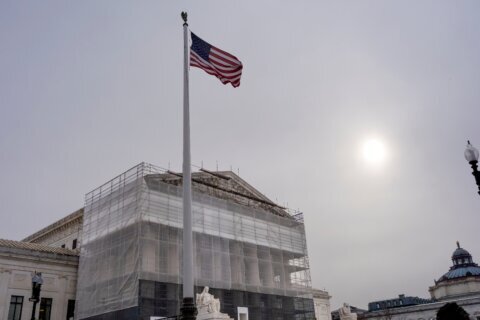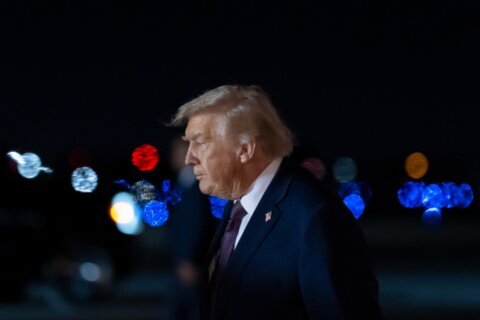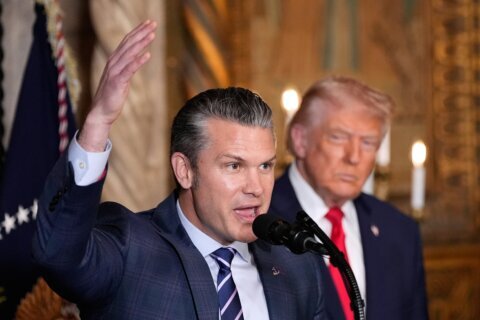The tension between President Donald Trump’s bellicose rhetoric and his non-interventionist foreign policy instincts was on full display Thursday afternoon as he huddled in the Situation Room.
Lawmakers in the room watched as the weight of his duties as commander-in-chief bore down on him, lives hanging in the balance.
Trump did not tip his hand on which way he was leaning, focusing instead on “drilling down” on the differing perspectives and arguments leveled by the assembled lawmakers, Senate Foreign Relations Chairman James Risch said. But it was clear, the Idaho Republican said, that Trump is a president who “doesn’t want to go to war.”
“I really watched him agonize over this. It comes down to one man,” Risch told a small group of reporters.
“The President was really wrestling with it,” House Armed Services Chairman Adam Smith, a Democrat, said.
Trump’s own dilemma was met by a near unanimous national security team who felt the US should retaliate for a downed drone by striking Iranian targets. For the President, though, the answer was far from obvious — ultimately he pulled the plug on military strikes, minutes before the point of no return.
But a senior US official said throughout the process, Trump was very invested and very serious. He very much understood that the military could not predict for him what the Iranian response to a US strike might be and it remains a significant administration concern not to start a wider war.
Military officials are pleased Trump didn’t order the strike because of this uncertainty. At the end of the day, many said they believe these Iranian attacks on tankers and the drone are basically a message that Iran wants to talk and they have been telling the President this.
On Friday, talk had turned to sanctions.
“We have additional avenues of sanctions pressure to impose. We have got additional sanctions for sure,” a senior administration official told a small group of reporters Friday. “I would not say that the President is thinking about military options. The primary thing we’re thinking about is additional sanctions.”
This official cautioned, however, that the President has not taken military action entirely off the table. “That’s an option the President maintains at all times,” said this official, adding “that’s really the President’s call.”
Developing throughout the day
Trump was still wrestling with how to respond to Iran’s downing of a US drone as he addressed reporters in the Oval Office on Thursday.
“You’ll find out,” Trump warned, ominously, as reporters peppered Trump with questions in the Oval Office about how he planned to retaliate. “They made a very big mistake.”
But pressed further, Trump explained that he didn’t just view that “mistake” as a strategic miscalculation that Iran would dearly pay for, but perhaps instead as a mistake of a different variety: an inadvertent error.
“I find it hard to believe it was intentional,” Trump said. “I think it could’ve been somebody that was loose and stupid.”
That cautious mindset would hang over Trump’s deliberations throughout the day as he huddled several times with his national security team, weighing a range of options for US retaliatory action. And after shedding those advisers who warned him of the consequences of withdrawing from the Iran nuclear deal — former Secretary of State Rex Tillerson, former Defense Secretary James Mattis and former national security adviser H.R. McMaster, among others — the President found himself surrounded by a phalanx of Iran hawks.
Chief among them, the President’s national security adviser John Bolton led the charge in recommending the President move forward with military strikes, an administration official said. Secretary of State Mike Pompeo and Vice President Mike Pence also supported moving forward with the strikes.
The recommendation to the President: strike three Iranian military targets — a set of radars and missile batteries — in a pre-dawn coordinated attack, according to a US official with direct knowledge of the operation.
A senior administration official said the President’s entire team of top national security advisers believed military strikes were “appropriate response” to Iran’s downing of a US drone.
“There was complete unanimity amongst the President’s advisers and DOD leadership on an appropriate response to Iran’s activities,” the official said. “The President made the final decision.”
Tellingly, the official noted that the unanimity on how to respond to Iran preceded the President’s decision to call off the strikes.
Wide range of voices
Trump wasn’t just hearing from his national security team as he mulled his options. He also spoke with outside advisers and friendly members of Congress who sought to remind him of his pledge to get the US out of endless wars in the Middle East and urged him to show restraint.
But as the President faced decision time, he was once again surrounded by those hand-picked advisers who have encouraged his hardline stance on Iran — from pulling out of the nuclear deal to imposing a series of crippling sanctions against the Iranian regime — and who were now pushing for the US to level serious consequences on Iran for downing a US drone, which the US contends was flying in international airspace.
In arguing for a military response, Bolton and other officials told the President that failing to punish the regime for the downing of the drone would be viewed as permission for Iran and other countries to continue behaving badly. In their discussions with Trump, the risk a strike might escalate tensions was raised — but characterized as an unlikely outcome to a necessary step.
Trump agreed to move forward with the strikes.
But between 7 p.m. and 8 p.m. ET on Thursday, as US military personnel in the region made final preparations for the airstrikes, Trump met once more with his advisers and military officials as the minutes counted down to the time of impact. It was the President’s last chance to object to the operation and call it off.
“They came in about a half hour before,” Trump said of the military brass. “And they said, ‘Sir, we’re ready to go. We’d like a decision.’ I said, ‘I want to know something before you go. How many people will be killed, in this case, Iranians?’ ”
“They said — came back, they said, ‘Sir, approximately 150,’ ” Trump recalled in an interview with NBC’s “Meet the Press.” “And I thought about it for a second and I said, ‘You know what? They shot down an unmanned drone, plane, whatever you want to call it. And here we are sitting with 150 dead people.’ ”
“I didn’t like it. I didn’t think — I didn’t think it was proportionate,” Trump said.
The decision to call of the operation minutes before it was set to take place hit at the heart of Trump’s concerns about escalating the conflict with Iran into war, one Trump might compare to the war in Iraq which he has frequently criticized.
Aides said Trump appeared wholly comfortable with his decision on Friday, without much second guessing. Instead, he liked the impression that he’s bucked the advice of his team, which he has previously criticized in private for appearing to march him toward war.
And while Trump seemed confident on Friday that he had made the right decision and was framing it appropriately — tweeting out a play-by-play on Twitter before addressing it in the NBC interview — Trump’s explanation did not explain why he had only learned how many casualties would result from the strikes minutes before they were to take place.
Casualty estimates are typically provided by military officials when presenting options to the President, and a White House official said Trump was given an estimated death toll long before he asked military officials for the count with just a half-hour to spare before the strikes. It’s not clear whether Trump did not hear, internalize or understand the death toll when it was first relayed to him earlier in the day.
Another administration official said that while Trump had received the casualty assessment earlier in the day, “he made the call when he internalized the severity of casualties.”







